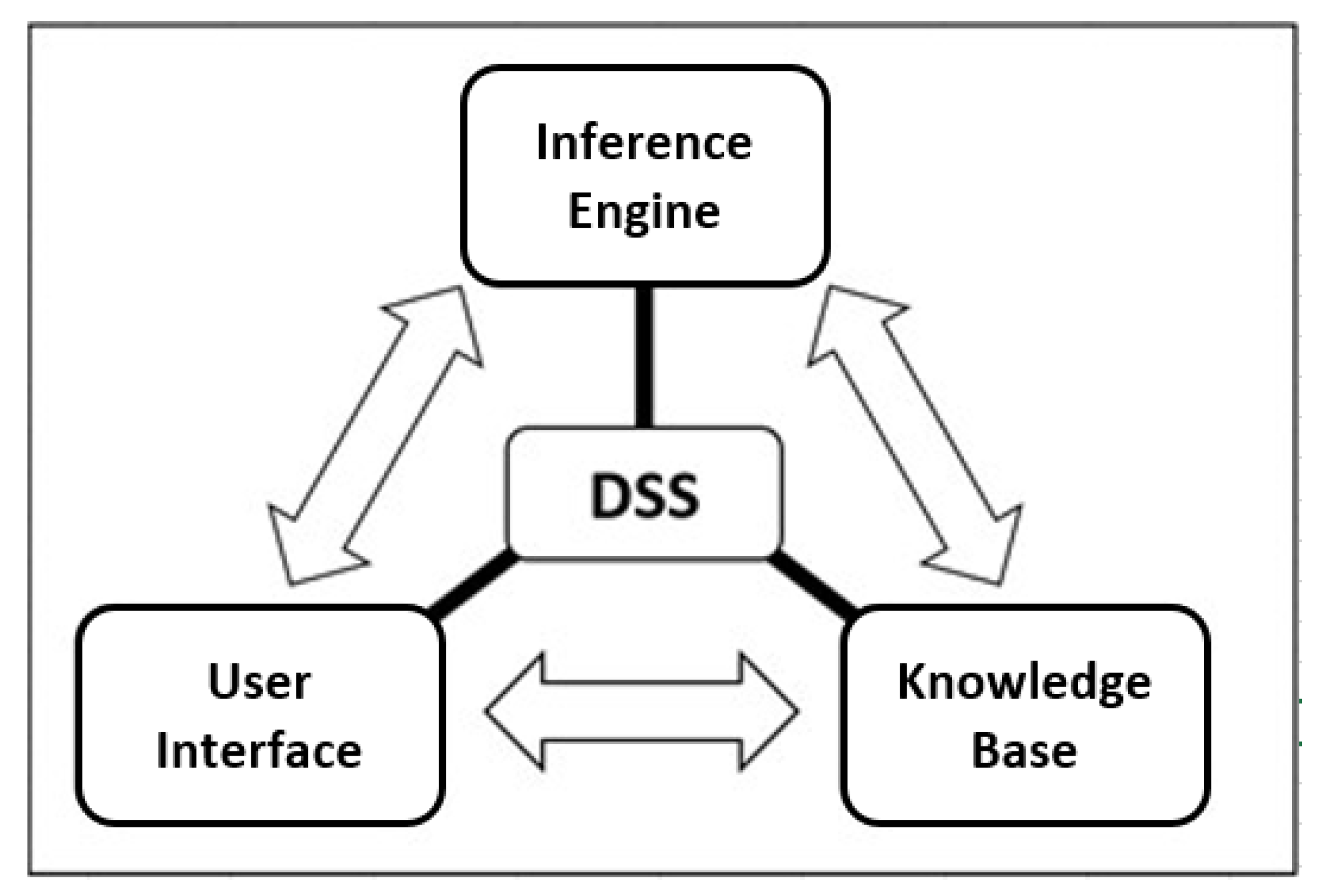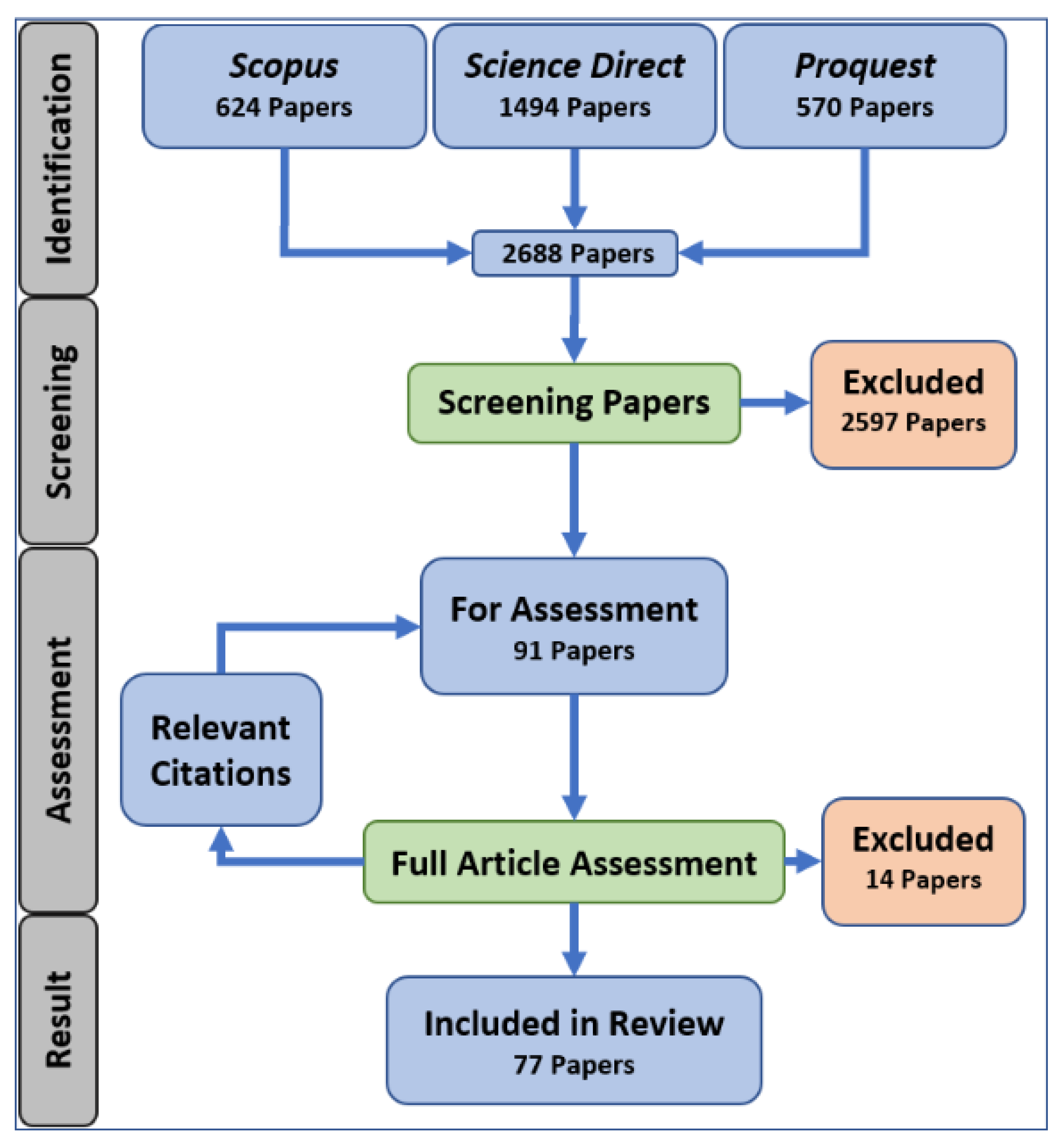Decision support systems (DSS) is a computer-based aid, which is designed to assist project managers in decision making when the tasks at hand are of a complex nature. Artificial intelligence (AI) is “the theory and development of computer systems able to perform tasks normally requiring human intelligence, such as visual perception, speech recognition, decision-making, and translation between languages”. The use of artificial intelligence (AI)-based decision support systems (DSS) has been gaining in popularity. AI technologies are becoming powerful tools throughout the world for improving project management; however, the advancement of construction management is still in its infancy and is adapting to the use of AI at a much slower pace than other sectors
- decision support system
- construction
- artificial intelligence
- machine learning
- sustainability
1. Introduction
1.1. Decision Support Systems

1.2. Sustainability in Construction
Economic Sustainability
Environmental Sustainability
Social Sustainability
1.3. Artificial Intelligence
Machine Learning
Fuzzy Logic
Natural Language Processing
Evolutionary Algorithms
Construction Project Lifecycle

2. Artificial Intelligence-Based Decision Support Systems in Project Sustainability
2.1. Categorizing the Task of the DSSs
Contractor and Supplier Evaluation
Design Optimization
Ref. [28] highlighted ongoing research into the use of DSSs for sustainable building material selection in the design stages, with a key focus on incorporating criteria for the environmental goals of sustainability. Ref. [29] developed a DSS for helping design engineers to choose sustainable materials during the planning stage of construction for pavement design. This method not only considers economic, environmental, and social goals during the project lifecycle but also for the maintenance of the materials during the lifecycle of the product. An example of AI being used for DSSs for design optimization would be [30], who developed a DSS for concept-design decision making in the construction industry. They adopted a Markov decision process (MDP) and RL for this DSS. The aim of this model was to implement value engineering from the manufacturing section into the construction design phase. The focus was to achieve optimization against environmental, economic, and social criteria. Utilizing the MDP approach was especially useful, as the structure of this approach has similarities to the decision-making system that engineers manually carry out in the concept-design stage of construction projects. The method was tested using the concept design of a house, and the design was optimized, which showed a positive result; however, there is area for improvement by adding feedback complexity and representing the interdependencies between different decisions at different stages of design.
Early-Stage Project Predictions
Dynamic Performance Prediction
The authors of [22], who proposed the evolutionary fuzzy hybrid neural network (EFHNN) for project cost prediction at early stages, clearly understood the benefits of creating a dynamic performance-prediction tool. This hybrid is a combination of FL for dealing with uncertain data, a high-order ANN for making predictions, and GA for optimizing the results. The same authors published a paper on their dynamic prediction performance method [39], which used the same hybrid AI algorithms to classify the performance of projects throughout the lifecycle. This classified project performance into four levels ranging from successful to disastrous, with inputs related to 10 time dependent variables, including change order data, weather impact, owner commitments, contractor commitments, recorded incidents, and overtime work. This model is classified with a high accuracy; however, the method was only validated against the highly similar evolutionary fuzzy neural inference model (EFNIM) and with only 12 projects for training and 3 projects for testing.
Safety Risk Assessment
Site Logistics
2.2. Observations and Trends Related to AI
2.3. Observations and Trends Related to Sustainability
It must be noted that this coincides with the increase in papers focused on design, site logistics, safety, and both supplier and contractor evaluation as shown in Figure 3. These studies have been noted to have a high percentage of consideration for the environmental and social goals of sustainability. EPP primarily focuses on the economic goal of sustainability when viewing bidding, claims, and cost prediction; however, there has been an area of EPP focused on project risk, of which most studies consider the three sustainability goals [43][44].

This entry is adapted from the peer-reviewed paper 10.3390/informatics9020043
References
- Rafiei, M.H.; Adeli, H. Novel Machine-Learning Model for Estimating Construction Costs Considering Economic Variables and Indexes. J. Constr. Eng. Manag. 2018, 144, 04018106.
- You, Z.; Wu, C. A framework for data-driven informatization of the construction company. Adv. Eng. Inform. 2019, 39, 269–277.
- You, Z.; Fu, H.; Shi, J. Design-by-analogy: A characteristic tree method for geotechnical engineering. Autom. Constr. 2018, 87, 13–21.
- Ahmed, S.; El-Sayegh, S. Critical Review of the Evolution of Project Delivery Methods in the Construction Industry. Buildings 2021, 11, 11.
- Rao, H.R.; Sridhar, R.; Narain, S. An active intelligent decision support system—Architecture and simulation. Decis. Support Syst. 1994, 12, 79–91.
- Keen, P.G.W. Adaptive design for decision support systems. SIGMIS Database 1980, 12, 15–25.
- Ranjbari, M. Three pillars of sustainability in the wake of COVID-19: A systematic review and future research agenda for sustainable development. J. Clean. Prod. 2021, 297, 126660.
- Böcker, L.; Meelen, T. Sharing for people, planet or profit? Analysing motivations for intended sharing economy participation. Environ. Innov. Soc. Transit. 2017, 23, 28–39.
- Azapagic, A.; Perdan, S. Indicators of Sustainable Development for Industry: A General Framework. Process Saf. Environ. Prot. 2000, 78, 243–261.
- Hong, J. Towards environmental sustainability in the local community: Future insights for managing the hazardous pollutants at construction sites. J. Hazard. Mater. 2021, 403, 123804.
- Fatourehchi, D.; Zarghami, E. Social sustainability assessment framework for managing sustainable construction in residential buildings. J. Build. Eng. 2020, 32, 101761.
- Abioye, S.O. Artificial intelligence in the construction industry: A review of present status, opportunities and future challenges. J. Build. Eng. 2021, 44, 103299.
- Bělohlávek, R.; Klir, G.J. Concepts and Fuzzy Logic; MIT Press: Cambridge, MA, USA, 2011.
- Chen, L.; Pan, W. Review fuzzy multi-criteria decision-making in construction management using a network approach. Appl. Soft Comput. 2021, 102, 107103.
- Awad, A.; Fayek, A.R. A decision support system for contractor prequalification for surety bonding. Autom. Constr. 2012, 21, 89–98.
- Hapke, H.; Howard, C.; Lane, H. Natural Language Processing in Action: Understanding, Analyzing, and Generating Text with Python; Manning: Shelter Island, NY, USA, 2019.
- Bilal, M. Big Data in the construction industry: A review of present status, opportunities, and future trends. Adv. Eng. Inform. 2016, 30, 500–521.
- Hagiwara, M. Real-World Natural Language Processing: Practical Applications with Deep Learning; Manning: Shelter Island, NY, USA, 2021.
- Baker, H.; Hallowell, M.R.; Tixier, A.J.P. Automatically learning construction injury precursors from text. Autom. Constr. 2020, 118, 103145.
- Back, T. Evolutionary Algorithms in Theory and Practice: Evolution Strategies, Evolutionary Programming, Genetic Algorithms; Oxford University Press: Oxford, UK, 1996.
- Pan, Y.; Zhang, L. Roles of artificial intelligence in construction engineering and management: A critical review and future trends. Autom. Constr. 2021, 122, 103517.
- Cheng, M.-Y.; Tsai, H.-C.; Sudjono, E. Conceptual cost estimates using evolutionary fuzzy hybrid neural network for projects in construction industry. Expert Syst. Appl. 2010, 37, 4224–4231.
- Ofori, G. The Construction Industry: Aspects of Its Economics and Management; Singapore University Press: Singapore, 1990.
- Vargas, R.V. A new approach to PMBOK guide 2000. In Proceedings of the Project Management Institute Annual Seminars & Symposium, Nashville, TN, USA, 1–10 November 2001; Project Management Institute: Newtown Square, PA, USA, 2001.
- Fallahpour, A.; Olugu, E.U.; Musa, S.N.; Wong, K.Y.; Noori, S. A decision support model for sustainable supplier selection in sustainable supply chain management. Comput. Ind. Eng. 2017, 105, 391–410.
- Kannan, D.; Mina, H.; Nosrati-Abarghooee, S.; Khosrojerdi, G. Sustainable circular supplier selection: A novel hybrid approach. Sci. Total Environ. 2020, 722, 137936.
- Luthra, S.; Govindan, K.; Kannan, D.; Mangla, S.K.; Garg, C.P. An integrated framework for sustainable supplier selection and evaluation in supply chains. J. Clean. Prod. 2017, 140, 1686–1698.
- Minhas, M.R.; Potdar, V.; Sianaki, O.A. A Decision Support System for Selecting Sustainable Materials in Construction Projects. In Proceedings of the 32nd International Conference on Advanced Information Networking and Applications Workshops (WAINA), Krakow, Poland, 16–18 May 2018; pp. 721–726.
- Santos, J.; Bressi, S.; Cerezo, V.; Presti, D.L. SUP&R DSS: A sustainability-based decision support system for road pavements. J. Clean. Prod. 2019, 206, 524–540.
- BuHamdan, S.; Alwisy, A.; Bouferguene, A. Explore the application of reinforced learning to support decision making during the design phase in the construction industry. Procedia Manuf. 2020, 42, 181–187.
- Tang, L.C.M.; Leung, A.Y.T.; Wong, C.W.Y. Entropic Risk Analysis by a High Level Decision Support System for Construction SMEs. J. Comput. Civ. Eng. 2010, 24, 81–94.
- Bilal, M.; Oyedele, L.O. Guidelines for applied machine learning in construction industry—A case of profit margins estimation. Adv. Eng. Inform. 2020, 43, 101013.
- Elmousalami, H.H. Intelligent methodology for project conceptual cost prediction. Heliyon 2019, 5, e01625.
- Marzouk, M.M.; Ahmed, R.M. A case-based reasoning approach for estimating the costs of pump station projects. J. Adv. Res. 2011, 2, 289–295.
- Zima, K. The Case-based Reasoning Model of Cost Estimation at the Preliminary Stage of a Construction Project. Procedia Eng. 2015, 122, 57–64.
- Kim, S. Hybrid forecasting system based on case-based reasoning and analytic hierarchy process for cost estimation. J. Civil Eng. Manag. 2013, 19, 737829.
- Koo, C.; Hong, T.; Hyun, C. The development of a construction cost prediction model with improved prediction capacity using the advanced CBR approach. Expert Syst. Appl. 2011, 38, 8597–8606.
- Car-Pusic, D.; Petruseva, S.; Zileska Pancovska, V.; Zafirovski, Z. Neural Network-Based Model for Predicting Preliminary Construction Cost as Part of Cost Predicting System. Adv. Civil Eng. 2020, 2020, 8886170.
- Cheng, M.-Y.; Tsai, H.-C.; Sudjono, E. Evolutionary fuzzy hybrid neural network for dynamic project success assessment in construction industry. Autom. Constr. 2012, 21, 46–51.
- Tixier, A.J.P.; Hallowell, M.R.; Rajagopalan, B.; Bowman, D. Application of machine learning to construction injury prediction. Autom. Constr. 2016, 69, 102–114.
- Greif, T.; Stein, N.; Flath, C.M. Peeking into the void: Digital twins for construction site logistics. Comput. Ind. 2020, 121, 103264.
- Ulubeyli, S.; Kazaz, A. Fuzzy multi-criteria decision making model for subcontractor selection in international construction projects. Technol. Econ. Dev. Econ. 2015, 22, e984363.
- Taylan, O.; Bafail, A.O.; Abdulaal, R.M.S.; Kabli, M.R. Construction projects selection and risk assessment by fuzzy AHP and fuzzy TOPSIS methodologies. Appl. Soft Comput. 2014, 17, 105–116.
- Hatefi, S.M.; Tamošaitienė, J. An integrated fuzzy DEMATEL-fuzzy ANP model for evaluating construction projects by considering interrelationships among risk factors. J. Civ. Eng. Manag. 2019, 25, 114–131.
